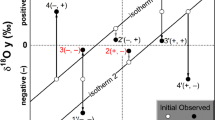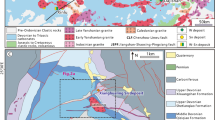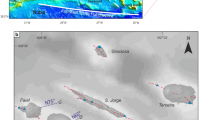Abstract
The Xi’an geothermal field is a typical medium–low-temperature group of geothermal reservoirs in the Guanzhong Basin. Three distinct groundwater systems occur in this field: the cold groundwater (CG) system (quaternary cold-water reservoir with a depth of less than 300 m); the shallow geothermal water (SGW) system (the Quaternary, Zhangjiapo Group, and Lantian-Bahe Group thermal reservoirs with depths ranging between 300 and 2000 m); the deep geothermal water (DGW) system (the Gaoling Group, Bailuyuan Group, and Proterozoic crystalline rock fissure thermal reservoirs, with depths of more than 2000 m). The chemical composition of the CG system consists of HCO3–Ca and HCO3–Ca–Mg water types with a low Total Dissolved Solids’ (TDS) content. The chemical composition of the SGW system consists of SO4–Na and SO4–HCO3–Na water types that have resulted from the partial mixing with water from the CG system through fault structures. Calculations suggest that about 39.4–42.7% of the water in the SGW system was derived from the CG system. The chemical composition of the DGW system consists of SO4–Na and SO4–Cl–Na water types with elevated TDS, F−, SiO2, and high ion concentrations due to the long residence time of water in this largely closed system. The use of geothermometers, multiple mineral equilibrium calculations, and the silica-enthalpy mixing model suggests that temperatures in the SGW and DGW systems lie in the range of 40–85 °C and 94.7–135 °C, respectively. The chalcedony geothermometer is considered to provide the most reliable temperature estimates of the shallow reservoir, whereas the quartzb (maximum steam loss 100 °C) and Na–K geothermometers are considered to provide the most reliable estimates for the deep thermal reservoir. The results of a Q-cluster classification of the water agree well with the field classification of the sampled waters, and the associations of the principal variables obtained by the R-cluster method are consistent with the results obtained by the conventional hydrogeochemical assessment of the samples.












Similar content being viewed by others
References
Abdel Moneim AA, Seleem EM, Zeid SA, Abdel Samie SG, Zaki S, El-Fotoh A, A (2015) Hydrogeochemical characteristics and age dating of groundwater in the Quaternary and Nubian aquifer systems in Wadi Qena, Eastern Desert, Egypt. Sustain Water Resour Manag 1(3):213–232
Adam P, Jan D (2008) Application of selected geothermometers to exploration of low-enthalpy thermal water: the Sudetic geothermal region in Poland. Environ Geol 58(8):1629–1638
Arnórsson S (1983) Chemical equilibria in icelandic geothermal systems—implications for chemical geothermometry investigations. Geothermics 12(2):119–128
Avsar O, Gulec N, Parlaktuna M (2013) Hydrogeochemical characterization and conceptual modeling of the Edremit geothermal field (NW Turkey). J Volcanol Geotherm Res 262:68–79
Avsar O, Kurtulus B, Gursu S, Kuscu GG, Kacaroglu F (2016) Geochemical and isotopic characteristics of structurally controlled geothermal and mineral waters of Mugla (SW Turkey). Geothermics 64:466–481
Ben Brahim F, Makni J, Bouri S, Ben Dhia H (2014) Evaluation of temperature and mixing process of water in deep and shallow aquifers in the southwestern Tunisia: case of Djerid region. Arab J Sci Eng 39(7):5677–5689
Chandrajith R, Barth JAC, Subasinghe ND, Merten D, Dissanayake CB (2013) Geochemical and isotope characterization of geothermal spring waters in Sri Lanka: evidence for steeper than expected geothermal gradients. J Hydrol 476:360–369
Chatterjee S, Sharma S, Ansari MA, Deodhar AS, Low U, Sinha UK, Dash A (2016) Characterization of subsurface processes estimation of reservoir temperature in Tural Rajwadi geothermal fields. Maharashtra India Geotherm 59:77–89
Cloutier V, Lefebvre R, Therrien R, Savard MM (2008) Multivariate statistical analysis of geochemical data as indicative of the hydrogeochemical evolution of groundwater in a sedimentary rock aquifer system. J Hydrol 353(3):294–313
Dassi L (2011) Investigation by multivariate analysis of groundwater composition in a multilayer aquifer system from North Africa: A multi-tracer approach. Appl Geochem 26(8):1386–1398
Foued B, Henia D, Lazhar B, Nabil M, Nabil C (2017) Hydrogeochemistry and geothermometry of thermal springs from the Guelma region, Algeria. J Geol Soc India 90(2):226–232
Fournier RO (1977) Chemical geothermometers and mixing models for geothermal systems. Geothermics 5(1):41–50
Fournier RO, Potter RWI (1982) Revised and expanded silica (quartz) geothermometer. Geotherm Resour Counc Bull 11:3–12
Fournier RO, Truesdell AH (1973) An empirical Na–K–Ca geothermometer for natural waters. Geochim Cosmochim Acta 37(5):1255–1275
Giggenbach WF (1988) Geothermal solute equilibria. Derivation of Na–K–Mg–Ca geoindicators. Geochim Cosmochim Acta 52(12):2749–2765
Guo QH, Wang YX (2012) Geochemistry of hot springs in the Tengchong hydrothermal areas, Southwestern China. J Volcanol Geotherm Res 215:61–73
Guo Q, Pang ZH, Wang YC, Tian J (2017) Fluid geochemistry and geothermometry applications of the Kangding high-temperature geothermal system in eastern Himalayas. Appl Geochem 81:63–75
Jiang GM, Wu QC (2009) Study on the sustainable development and utilization of geothermal water resources in Xi’an city. Geol Resour 18(03):210–213 (in Chinese)
Karimi S, Mohammadi Z, Samani N (2017) Geothermometry and circulation depth of groundwater in Semnan thermal springs, Northern Iran. Environ Earth Sci 76(19):659
Li PY, Li XY, Meng XY, Li MN, Zhang YT (2016a) Appraising groundwater quality and health risks from contamination in a semiarid region of northwest China. Expo Health 8(3):361–379
Li PY, Wu JH, Qian H (2016b) Preliminary assessment of hydraulic connectivity between river water and shallow groundwater and estimation of their transfer rate during dry season in the Shidi River, China. Environ Earth Sci 75(2):99–114
Li PY, Zhang YT, Yang NA, Jing LJ, Yu PY (2016c) Major ion chemistry and quality assessment of groundwater in and around a mountainous tourist town of China. Expo Health 8(2):239–252
Li J, Yang G, Sagoe G, Li Y (2018) Major hydrogeochemical processes controlling the composition of geothermal waters in the Kangding geothermal field, western Sichuan province. Geothermics 75:154–163
Liu CW, Jang CS, Chen CP, Lin CN, Lou KL (2008) Characterization of groundwater quality in Kinmen Island using multivariate analysis and geochemical modelling. Hydrol Process 22(3):376–383
Liu YP, Zhou X, Deng ZJ, Fang B, Tsutomu Y, Zhao JB, Wang XC (2015) Hydrochemical characteristics and genesis analysis of the Jifei hot spring in Yunnan, southwestern China. Geothermics 53:38–45
López-Chicano M, Bouamama M, Vallejos A, Pulido-Bosch A (2001) Factors which determine the hydrogeochemical behaviour of karstic springs. A case study from the Betic Cordilleras. Spain Appl Geochem 16(9):1179–1192
Lu LH, Pang ZH, Kong YL, Guo Q, Wang YC, Xu CH, Gu W, Zhou LL, Yu DD (2018) Geochemical and isotopic evidence on the recharge and circulation of geothermal water in the Tangshan geothermal system near Nanjing, China: implications for sustainable development. Hydrogeol J 26(5):1705–1719
Lund JW, Boyd TL (2016) Direct utilization of geothermal energy 2015 worldwide review. Geothermics 60:66–93
Ma ZY, Li XC, Zheng HJ, Li JB, Pei B, Guo S, Zhang XL (2017) Origin and classification of geothermal water from Guanzhong Basin, NW China: geochemical and isotopic approach. J Earth Sci 28(4):719–728
Makni J, Bouri S, Ben Dhia H (2013) Hydrochemistry and geothermometry of thermal groundwater of southeastern Tunisia (Gabes region). Arab J Geosci 6(7):2673–2683
Michael K, Golab A, Shulakova V, Ennis-King J, Allinson G, Sharma S, Aiken T (2010) Geological storage of CO2 in saline aquifers—a review of the experience from existing storage operations. Int J Greenhouse Gas Control 4(4):659–667
Mondal NC, Singh VP, Singh VS, Saxena VK (2010) Determining the interaction between groundwater and saline water through groundwater major ions chemistry. J Hydrol 388(1):100–111
Morey GW, Fournier RO, Rowe JJ (1962) The solubility of quartz in water in the temperature interval from 25 to 300 °C. Geochim Cosmochim Acta 26(10):1029–1043
Mutlu H, Kılıç A (2009) Geothermometry applications for the Balıkesir thermal waters. Turk Environ Geol 56(5):913–920
Palandri JL, Reed MH (2001) Reconstruction of in situ composition of sedimentary formation waters. Geochim Cosmochim Acta 65(11):1741–1767
Pang ZH (2001) Isotope and chemical geothermometry and its applications. Sci China Ser E Technol Sci 44(1):16–20
Piper AM (1944) A graphic procedure in the geochemical interpretation of water-analyses. Eos Trans Am Geophys Union 25(6):914–928
Pirlo MC (2004) Hydrogeochemistry and geothermometry of thermal groundwaters from the Birdsville Track Ridge, Great Artesian Basin, South Australia. Geothermics 33(6):743–774
Qin DJ, Pang ZH, Turner JV, Wen XR, Zhao YD, Xu XL, Liu T (2005a) Isotopes of geothermal water in Xi’an area and implication on its relation to karstic groundwater in North Mountains. Acta Petrol Sin(05): 1489–1500 (in Chinese)
Qin DJ, Turner JV, Pang ZH (2005b) Hydrogeochemistry and groundwater circulation in the Xi’an geothermal field, China. Geothermics 34(4):471–494
Reed M, Spycher N (1984) Calculation of pH and mineral equilibria in hydrothermal waters with application to geothermometry and studies of boiling and dilution. Geochim Cosmochim Acta 48(7):1479–1492
Sanada T, Takamatsu N, Yoshiike Y (2006) Geochemical interpretation of long-term variations in rare earth element concentrations in acidic hot spring waters from the Tamagawa geothermal area. Jpn Geotherm 35(2):141–155
Swanson SK, Bahr JM, Schwar MT, Potter KW (2001) Two-way cluster analysis of geochemical data to constrain spring source waters. Chem Geol 179(1):73–91
Wang X, Wang G, Lu C, Gan H, Liu Z (2018) Evolution of deep parent fluids of geothermal fields in the Nimu–Nagchu geothermal belt. Tibet China Geotherm 71:118–131
Xu GF (2014) Isotope and hydrochemical evidence of Genetic about deep geothermal water, as the central of guanzhong basin for an example. M.S. Thesis, Chang’an University, Xi’an, China (in Chinese)
Yang PH, Cheng Q, Xie SY, Wang JL, Chang LR, Yu Q, Zhan ZJ, Chen F (2017) Hydrogeochemistry and geothermometry of deep thermal water in the carbonate formation in the main urban area of Chongqing, China. J Hydrol 549:50–61
Zhang XD, Qian H, Chen J, Qiao L (2014) Assessment of groundwater chemistry and status in a heavily used semi-arid region with multivariate statistical analysis. Water 6(8):2212–2232
Acknowledgements
This study was financially supported by the National Natural Science Foundation of China (Grant No. 41572236). And the completion of this article was inseparable from the contributions of all authors. Their support is gratefully acknowledged.
Author information
Authors and Affiliations
Corresponding author
Additional information
Publisher’s Note
Springer Nature remains neutral with regard to jurisdictional claims in published maps and institutional affiliations.
Rights and permissions
About this article
Cite this article
Xu, P., Li, M., Qian, H. et al. Hydrochemistry and geothermometry of geothermal water in the central Guanzhong Basin, China: a case study in Xi’an. Environ Earth Sci 78, 87 (2019). https://doi.org/10.1007/s12665-019-8099-1
Received:
Accepted:
Published:
DOI: https://doi.org/10.1007/s12665-019-8099-1




